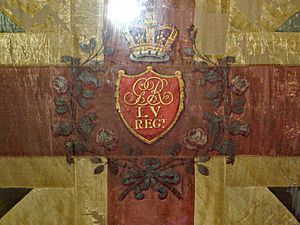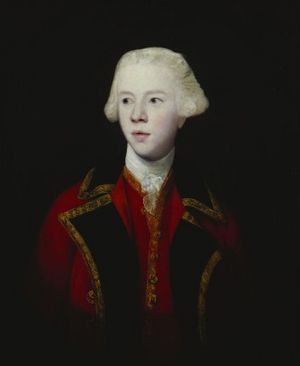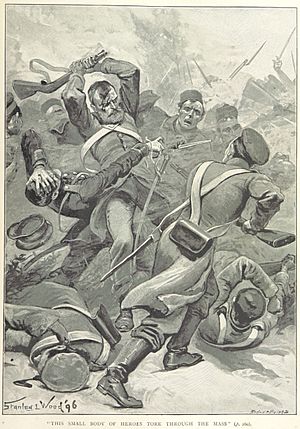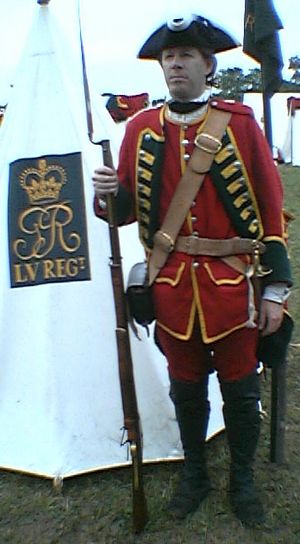55th (Westmorland) Regiment of Foot facts for kids
Quick facts for kids 55th (Westmorland) Regiment of Foot |
|
|---|---|

Detail from 1786 Regimental colour of the 55th (Westmorland) Regiment.
|
|
| Active | 1755–1881 |
| Country | |
| Branch | |
| Role | Infantry |
| Size | One battalion |
| Garrison/HQ | Carlisle Castle |
| Nickname(s) | "The Cattle Reavers" "The Two Fives" |
| Colours | Dark-green facings, gold lace |
| Engagements | French and Indian War Pontiac's War American Revolutionary War French Revolutionary Wars Napoleonic Wars Fifth Xhosa War Coorg War First Opium War Crimean War Bhutan War |
| Commanders | |
| Notable commanders |
George Augustus, Lord Howe |
The 55th Regiment of Foot was a special group of infantry soldiers in the British Army. It was formed in 1755. After 1782, it added a county name, becoming the 55th (Westmorland) Regiment of Foot.
In 1881, this regiment joined with another, the 34th (Cumberland) Regiment of Foot. Together, they formed a new group called the Border Regiment. This change happened because of something called the Childers Reforms, which reorganized the British Army.
Contents
History of the 55th Regiment
How the Regiment Started
The regiment began in Stirling, Scotland, in 1755. It was first called the 57th Regiment of Foot. Colonel George Perry helped create it to fight in the Seven Years' War.
In 1756, two other regiments were disbanded, meaning they were closed down. Because of this, the 57th Regiment was re-ranked and became the 55th Regiment of Foot.
Fighting in the French and Indian War

The regiment traveled to North America in 1757 to fight in the French and Indian War. They arrived in Nova Scotia on July 8, 1757. Their first mission was to attack the Fortress of Louisbourg, but this attack was called off.
After Colonel Perry died, Lord George Augustus Viscount Howe became the regiment's new leader in September 1757. When the regiment reached Albany, New York, Lord Howe went on a scouting trip with Major Robert Rogers. Rogers led a group of American rangers. Howe wanted to learn "bush fighting," which meant fighting in forests and wild areas.
Lord Howe was very respected by both American colonists and British soldiers. He was known as the "Idol of the army." In 1758, he started training his men to fight more like rangers. He also changed their equipment to better suit warfare in America. Sadly, Lord Howe was killed in a small fight in July 1758, the day before the Battle of Carillon.
After Lord Howe's death, John Prideaux took command. In July 1759, Prideaux was also killed by accident during the Battle of Fort Niagara. He was hit by a blast from a small cannon called a cohorn.
Later that month, the regiment joined General Jeffery Amherst's army. They fought in the Battle of Ticonderoga and helped capture Fort Crown Point. In 1760, Colonel James Adolphus Oughton led the regiment up the Saint Lawrence River. They were part of the Montreal Campaign from August to September 1760. William Gansell became the colonel in 1762.
Pontiac's War: A Tough Time
In the summer of 1763, some soldiers from the regiment volunteered to help at Fort Detroit. This British fort was under attack by Native Americans led by Pontiac. On their way, the British soldiers were ambushed at the Battle of Bloody Run in July 1763. Many were badly hurt.
In 1764, many surviving members of the 55th Regiment were moved to the 17th Regiment of Foot. This was not popular. One officer's daughter, Anne Grant, wrote that they were joining a regiment they had once "held in the utmost contempt."
Fighting in the American Revolutionary War
The regiment returned to North America for the American Revolutionary War. They fought in the Battle of Long Island in August 1776 and the Battle of Princeton in January 1777.
They also took part in the Philadelphia campaign. They saw action at the Battle of Brandywine in September 1777, the Battle of Paoli later that month, and the Battle of Germantown in October 1777.
In November 1778, the regiment moved to the West Indies. They fought in the Battle of St. Lucia in December 1778. In February 1782, most of the regiment was captured during the siege of Brimstone Hill on Saint Kitts. This happened when the French invaded the island. In August 1782, the regiment added "the Westmoreland" to its name, becoming the 55th (the Westmoreland) Regiment of Foot.
The Napoleonic Wars Era
In 1793, the regiment went to Flanders to fight in the French Revolutionary Wars. They saw action at the siege of Ypres in June 1794.
They then moved to the West Indies. They took part in attacks on Martinique in February 1794, Saint Lucia in April 1794, and Guadeloupe later that month. They also helped capture Saint Lucia again in May 1796. In June 1796, they helped stop a rebellion by Caribs on Saint Vincent.
After returning to England in 1797, the regiment landed at Ostend in 1798. They served in the Anglo-Russian invasion of Holland. They fought at the Battle of Bergen in September 1799 and the Battle of Alkmaar in October 1799.
They came home in 1800 but were sent back to the West Indies that same year. In July 1809, they helped Britain's new Spanish allies during the Spanish reconquest of Santo Domingo. The regiment returned home in 1812. In 1813, they went to Holland and took part in the siege of Bergen op Zoom in March 1814.
The Victorian Era: New Conflicts

In 1819, the regiment sailed to the Cape of Good Hope in Africa. They fought in the Fifth Xhosa War. They also served in the Coorg War in 1834.
In 1841, the regiment was sent to China for the First Opium War. They were chosen for a special force that moved north from Hong Kong. They fought in the Battle of Amoy in August 1841.
The regiment was the first to land when British forces arrived at the Capture of Chusan in October 1841. They landed on a beach and then attacked a strong enemy position called Guards Hill. They climbed the hill under heavy fire and captured it. Then, they took the high ground overlooking Tinghai. Immediately after, they placed their regimental colours (flags) on the city walls. After the battle, some soldiers from the 55th and 18th Regiment of Foot stayed to protect the city. On October 10, 1841, the 55th again fought Qing troops at the Battle of Chinhai. The regiment stayed to guard the city for the rest of the year.
In 1842, the regiment fought at Chapu in May and Chinkiang in July. They then guarded Chinkiang until the Treaty of Nanking was signed, ending the war. Part of the regiment stayed in Hong Kong after the war. For their brave service, they were allowed to add a dragon badge with the word "China" to their regimental flag.
The regiment also served in Turkey and Russia during the Crimean War. They fought in the Battle of Alma in September 1854, the Battle of Inkerman in November 1854, and the siege of Sevastopol in the winter of 1854.
After returning home in 1857, they were sent to India in 1863. They saw action during the Bhutan War in 1864.
Joining the Border Regiment
In the 1870s, the British Army made changes called the Cardwell Reforms. Smaller regiments were linked together to share a single training base and recruiting area. The 55th Regiment was linked with the 34th (Cumberland) Regiment of Foot. Their shared base was at Carlisle Castle.
On July 1, 1881, more changes came with the Childers Reforms. The 55th Regiment officially joined with the 34th Regiment to form the Border Regiment. The former 55th Regiment became the 2nd battalion of this new regiment. Today, there is a special memorial chapel for the Border Regiment at Kendal Parish Church. This chapel holds the original flags of the 55th Regiment.
Battle Honours
The regiment earned special recognition for its bravery in these battles:
- American Revolutionary War (1775–78); St Lucia, 1778
- Crimean War (1854–55); Alma, Inkerman, Sevastopol
Victoria Cross Heroes
Two soldiers from the regiment were awarded the Victoria Cross. This is the highest award for bravery in the British military:
- Private Thomas Beach, during the Crimean War (November 5, 1854)
- Brevet Major Frederick Cockayne Elton, during the Crimean War (March 29, 1855)



